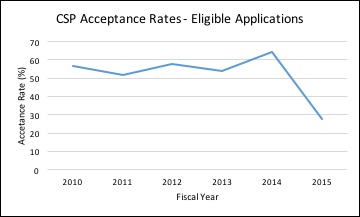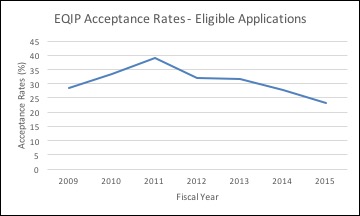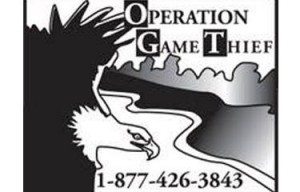From National Sustainable Agriculture Coalition
As Congress continues to negotiate funding levels for fiscal year (FY) 2016, key conservation programs are once again on the chopping block. The severe magnitude of those cuts are described at the end of this post.
As we write this, congressional leaders and appropriators are in the final stretch of making the government funding decisions for FY 2016, with the potential of reducing or eliminating the farm bill conservation program cuts in light of extra funding recently provided by the two-year budget deal.
Re-opening the 2014 Farm Bill to make these shortsighted cuts impacts the ability of farmers and ranchers to enroll in critical conservation programs, and this post illustrates just how dramatically these funding cuts have impacted program acceptance rates in recent years.
Working lands conservation programs help farmers and ranchers to protect and rebuild soil, provide clean water and habitat for native wildlife, sequester carbon, and supply other conservation and environmental benefits. To protect these benefits and the carefully negotiated 2014 Farm Bill, the National Sustainable Agriculture Coalition (NSAC) urges Congress to avoid any further backdoor cuts that will shut the door to conservation funding for even more farmers with eligible conservation proposals to protect and enhance the natural resource base on which our food security depends.
What’s at Stake?
The Conservation Stewardship Program (CSP) and the Environmental Quality Incentives Program (EQIP) are both administered by the U.S. Department of Agriculture (USDA)’s Natural Resources Conservation Service (NRCS) and are the farm bill’s two large working lands conservation programs.
- CSP provides farmers and ranchers technical and financial assistance to actively manage existing conservation and to implement additional conservation activities. CSP is the only comprehensive working lands conservation program designed to help farmers and ranchers adopt and maintain advanced land management conservation systems on land in agricultural production.
- EQIP provides financial cost-share assistance and technical assistance for producers to implement basic conservation practices on working agricultural land. EQIP assistance is available through a general pool and also through special initiatives.
CSP and EQIP both had exceptionally low acceptance rates for FY 2015, at 27 and 23 percent respectively, which reflects not only the 2 to 1 ratio of demand to funding that we would expect under “normal” funding conditions, but also backdoor farm bill cuts in annual appropriations bills, as well as automatic budget cuts known as sequestration, were also in play during the last few rounds of conservation funding.
Only 27 Percent of CSP Applications Funded in FY 2015
In FY 2015, nearly 21,000 eligible producers applied for funding through CSP. This excludes applications that did not meet the minimum eligibility criteria. Of those eligible applicants, only 5,785 producers (27 percent) were funded in FY 15.
As the chart below illustrates, this represents a historic low in the percentage of eligible applicants that CSP is able to support. While CSP is indeed intended to support only the best stewards of the land, the 2015 acceptance rate reflects a dramatic disconnect between eligible stewards and available funding. Until 2015 NRCS had been able to fund approximately half of the eligible CSP applicants they received.

Why was the 2015 Acceptance Rate So Low?
There are a number of factors that influence CSP funding each year, including most importantly the amount mandatory funding authorized in the farm bill, but also cuts known as “changes in mandatory program spending” (known as CHIMPS in congressional shorthand) made through the annual appropriations process, and automatic spending cuts known as “sequestration.” All of these factors combined in a kind of “perfect storm” that worked against farmers and ranchers who applied to CSP in FY 2015.
First, the 2014 Farm Bill decreased the annual enrollment in CSP down to 10 million acres, rather than 12.8 million acres per year as was the case under the 2008 Farm Bill. The new acreage cap meant that beginning in FY 2014, NRCS was able to enroll 2.8 million few acres in the program. This amounts to roughly an additional 2,000 farmers and ranchers who have to be turned away from the CSP each year.
While the enrollment cap of 10 million acres was also applied for the FY 2014 sign-up, the 2015 sign-up was further limited by an additional 23 percent cut, limiting program enrollment to 7.7 million acres, via the annual appropriations process. This CHIMPS cut directly cut into the ability of producers to enroll in key conservation programs, and fiscal year (FY) 2015’s historically low acceptance rate illustrates the damage done by continued cuts. The was no CHIMPS cut in FY 2014.
Finally, the sequestration process cut an additional over 7 percent of program funding (for both CSP and EQIP) in FY 2015. These automatic cuts keep getting extended by Congress and under current law will continue to cut farm bill farm until 2025, and hence will have a major impact on the 2018 Farm Bill process. These automatic spending cuts have so far impacted enrollment from 2013 through 2015, and will again influence 2016 enrollment, although we do not yet know the exact size of the cut.
These factors together, along with continued and increasing farmer demand for the program, are driving down acceptance rates and creating major backlogs, not to mention discouraged farmers and lost conservation opportunities.
Less than One Quarter of EQIP Applicants Accepted in 2015
In FY 2015, EQIP had a similarly low acceptance rate, as NRCS was only able to enroll 30,175, or 23 percent, of the nearly 130,000 eligible applicants. As the chart below illustrates, since 2011 it has become increasingly challenging for eligible EQIP applicants to receive cost-share support for critical conservation practices.

While EQIP funding remained fairly level in the 2014 Farm Bill, one change from the farm bill that could be impacting the low acceptance rates in 2014 and 2015 is the increase, included in the 2014 Farm Bill, in the payment limit from $300,000 to $450,000 per contract. This increase in the upper payment limit means that large concentrated animal feeding operations (CAFOs) and large operations expanding irrigated acres are able to commandeer more of the total funding, thus reducing access to the program for other farmers and ranchers.
Finally, in addition to farm bill changes, EQIP funding continues to suffer major cuts through CHIMPS in the annual appropriations process, as well as cuts through sequestration since 2013. The final FY 2015 appropriations bill cut EQIP by over $136 million, on top of the $117 million cut through sequestration.
Given that the CHIMPS cut to EQIP in FY 2014 was an even larger $274 million, it is possible that there were additional factors influencing 2015’s historically low acceptance rate, including the size of accepted applications, the timing of application periods, and NRCS program outreach at the state and local levels.
Looking Ahead to 2016
The low acceptance and high backlog rates for CSP and EQIP reflect farmers and ranchers’ continued conservation demand across the country, as well as the serious cuts to these programs, year after year. The clock is ticking for Congress to finalize funding levels for 2016, and the proposed cut to CSP in the House Agriculture Appropriations bill and to EQIP in the Senate and House would have serious implications for eligible producers to enroll in critical conservation programs.
Given that the budget deal announced in late October lifted discretionary spending caps for FY 2016 and gave appropriators more money to work with, it is our hope that with the additional funding they will eliminate the 23 percent cut to CSP in the House bill and the over $300 million cut to EQIP in both the pending House and Senate bills. If not eliminated, these shortsighted cuts would force NRCS to turn away thousands additional of farmers and ranchers looking to improve soil and water quality, protect pollinators and habitat, conserve water, and prepare for extreme weather events.
Application periods for EQIP are open across the country, and we expect CSP (in an entirely new and redesigned form) to be rolled out early next year. Stay tuned for more information on program funding and sign-up periods in the coming weeks and months.



